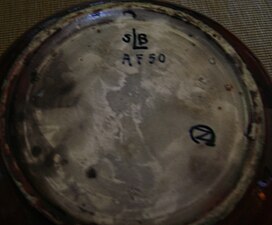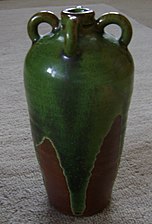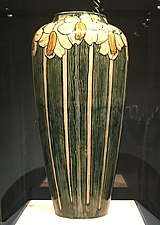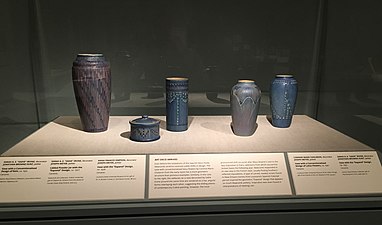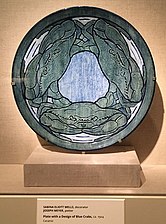
H. Sophie Newcomb Memorial College, or Newcomb College, was the coordinate women's college of Tulane University located in New Orleans, in the U.S. state of Louisiana. It was founded by Josephine Louise Newcomb in 1886 in memory of her daughter.

Chinese ceramics show a continuous development since pre-dynastic times and are one of the most significant forms of Chinese art and ceramics globally. The first pottery was made during the Palaeolithic era. Chinese ceramics range from construction materials such as bricks and tiles, to hand-built pottery vessels fired in bonfires or kilns, to the sophisticated Chinese porcelain wares made for the imperial court and for export. Porcelain was a Chinese invention and is so identified with China that it is still called "china" in everyday English usage.
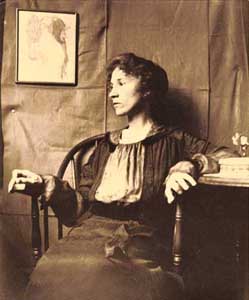
Sarah Agnes Estelle (Sadie) Irvine was an American artist and educator. Her work is associated with the Newcomb College pottery school, where she studied and taught until her retirement in 1952.
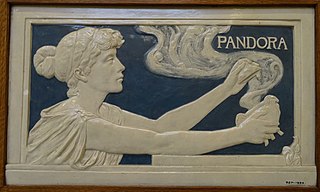
The Della Robbia Pottery was a ceramic factory founded in 1894 in Birkenhead, near Liverpool, England. It closed in 1906. Initially it mostly made large pieces with high artistic aspirations, especially relief panels for architectural use, but also ornamental vessels and plates, intended for display rather than use.

Mintons was a major company in Staffordshire pottery, "Europe's leading ceramic factory during the Victorian era", an independent business from 1793 to 1968. It was a leader in ceramic design, working in a number of different ceramic bodies, decorative techniques, and "a glorious pot-pourri of styles - Rococo shapes with Oriental motifs, Classical shapes with Medieval designs and Art Nouveau borders were among the many wonderful concoctions". As well as pottery vessels and sculptures, the firm was a leading manufacturer of tiles and other architectural ceramics, producing work for both the Houses of Parliament and United States Capitol.

A slip is a clay slurry used to produce pottery and other ceramic wares. Liquified clay, in which there is no fixed ratio of water and clay, is called slip or clay slurry which is used either for joining leather-hard (semi-hardened) clay body together by slipcasting with mould, glazing or decorating the pottery by painting or dipping the pottery with slip. Pottery on which slip has been applied either for glazing or decoration is called slipware.
The Overbeck sisters were American women potters and artists of the Arts and Crafts Movement who established Overbeck Pottery in their Cambridge City, Indiana, home in 1911 with the goal of producing original, high-quality, hand-wrought ceramics as their primary source of income. The sisters are best known for their fanciful figurines, their skill in matte glazes, and their stylized designs of plants and animals in the Art Nouveau and Art Deco styles. The women owned and handled all aspects of their artistic enterprise until 1955, when the last of the sisters died and the pottery closed. As a result of their efforts, the Overbecks managed to become economically independent and earned a modest living from the sales of their art.
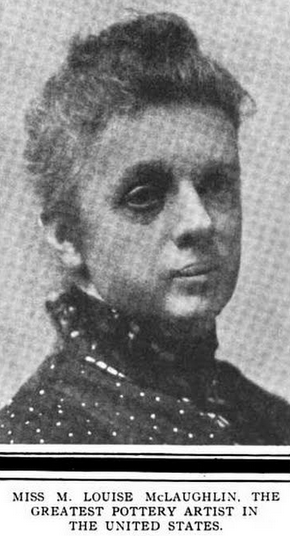
Mary Louise McLaughlin was an American ceramic painter and studio potter from Cincinnati, Ohio, and the main local competitor of Maria Longworth Nichols Storer, who founded Rookwood Pottery. Like Storer, McLaughlin was one of the originators of the art pottery movement that swept the United States.

Adelaide Alsop Robineau (1865–1929) was an American china painter and potter, and is considered one of the top ceramists of American art pottery in her era.

Art pottery is a term for pottery with artistic aspirations, made in relatively small quantities, mostly between about 1870 and 1930. Typically, sets of the usual tableware items are excluded from the term; instead the objects produced are mostly decorative vessels such as vases, jugs, bowls and the like which are sold singly. The term originated in the later 19th century, and is usually used only for pottery produced from that period onwards. It tends to be used for ceramics produced in factory conditions, but in relatively small quantities, using skilled workers, with at the least close supervision by a designer or some sort of artistic director. Studio pottery is a step up, supposed to be produced in even smaller quantities, with the hands-on participation of an artist-potter, who often performs all or most of the production stages. But the use of both terms can be elastic. Ceramic art is often a much wider term, covering all pottery that comes within the scope of art history, but "ceramic artist" is often used for hands-on artist potters in studio pottery.

Newcomb Art Museum of Tulane University is an art museum located in the Woldenberg Art Center on the campus of Tulane University in New Orleans, Louisiana, United States. It has been historically known for its significant collection of Newcomb Pottery and other crafts produced at Newcomb College, as well as administering the art collections of the university. Since 2014, the institution has increasingly focused on exhibitions and programs that explore socially engaged art, civic dialogue, and community transformation.

Charles Fergus Binns was an English-born studio potter. Binns was the first director of the New York State School of Clayworking and Ceramics, currently called the New York State College of Ceramics at Alfred University. He began his position in 1900 and retired in 1931. His work included authorship of several books on the history and practice of pottery. Some of his more notable students included Arthur Eugene Baggs, William Victor Bragdon, R. Guy Cowan, Maija Grotell, Elizabeth Overbeck, and Adelaide Alsop Robineau. This has led Binns to be called "the father of American studio ceramics".

Mary Given Sheerer (1865–1954) was an American ceramicist, designer, and art educator, best known for her affiliation with the Newcomb Pottery project at H. Sophie Newcomb Memorial College, now part of Tulane University.

Harriet Coulter Joor (1875–1965) was an American artist, writer, textile and ceramics designer, and pottery decorator. Joor was among the earliest graduates of H. Sophie Newcomb Memorial College, and was one of the original producers of Newcomb Pottery.
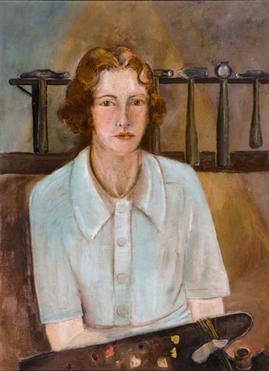
Rosalie Roos Wiener (1899–1982) was an art student and an artist at Newcomb College from 1923 until the late 1930s. She specialized in metalwork and jewelry making, working with silver, copper, brass, tin, and gold.

American art pottery refers to aesthetically distinctive hand-made ceramics in earthenware and stoneware from the period 1870-1950s. Ranging from tall vases to tiles, the work features original designs, simplified shapes, and experimental glazes and painting techniques. Stylistically, most of this work is affiliated with the modernizing Arts and Crafts (1880-1910), Art Nouveau (1890–1910), or Art Deco (1920s) movements, and also European art pottery.

The Coxwold Pottery was a pottery studio based in the village of Coxwold, North Yorkshire, England, launched by artist potters Peter and Jill Dick in 1965, and in operation until 2012.

Ron Meyers is an American studio potter and ceramics teacher known for producing functional pottery featuring animal and human forms. His work is featured in numerous museums and notable collections, including the Smithsonian American Art Museum, the Georgia Museum of Art, and the Rosenfield Collection, and he has presented more than 100 workshops in the US and internationally. He has been described as "one of his generation's most important potters" and "an icon of the American ceramics community."
Jan Dunn born in Springvale, Victoria, Australia, was a potter, ceramicist and teacher.

The pottery collection of the Albert Hall Museum in Jaipur, India, is a diverse 19th-century collection. The collection represents a wide range of crafts, techniques, and regions. The display includes unglazed vessels with ornamental decoration. The pottery techniques on display include burnished, lacquered, slip-painted, incised wares, and glazed pottery. The museum has representative pieces of Indian craftsmanship and other international pottery styles.








